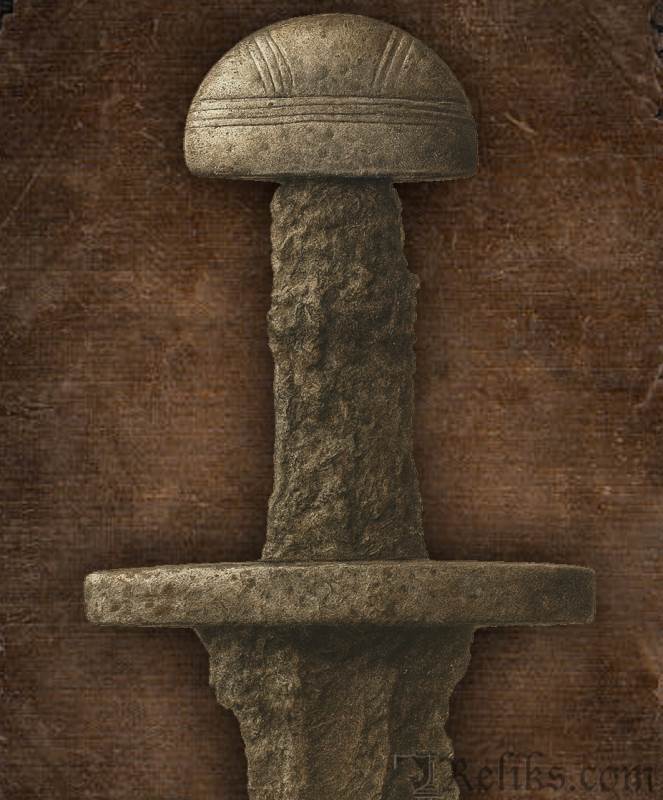Viking Sword Type W – The Bronze “Ghost Pommel” (c. 900–950)
A Curious Hybrid
Among the Viking sword typology, Type W stands out as one of the strangest. At first glance, it looks like a tripartite pommel hilt in the tradition of Types D, E, or R. But look closer and the illusion begins to crack. The pommel isn’t separate at all—nor are the guards. Instead, the entire upper hilt was cast in bronze as a single block, with shallow grooves and scratch-marks “pretending” to divide guard from pommel. In other words, Type W is a bronze hilt playing dress-up, a “ghost pommel” mimicking high-status styles in a simpler, sturdier form.
Anatomy of the Hilt

Viking Sword Type W – The Bronze Ghost Pommel
The recipe was consistent: one solid bronze piece for the over-guard and pommel, paired with a plain iron lower guard. Across the bronze, smiths cut three horizontal grooves to simulate the seam between guard and pommel. Short transverse strokes hinted at the three lobes of a traditional pommel, though they never existed in true form. In profile, the sides are half-circular and flat, a compact block that’s unmistakable once you’ve seen it.
Decoration was modest but deliberate. Most hilts carry simple incised schemes—branching lines or circles linked by lines—while one outlier (from Hundstad, Buskerud) experiments with entrelac in the Insular style. A few hilts even show tick-mark borders along the guards, echoing in miniature the stripe-inlaid fashion of Types H, I, and K.
Blades, where preserved, are always double-edged, but no inscriptions have yet been confirmed on the Norwegian examples.
Where They’re Found
Type W is exceedingly rare. Only eight examples are known in Norway, clustered in the west and in Trøndelag, with one lone find in Buskerud. Beyond Norway, a single close cousin exists in Östergötland, Sweden. Unlike richer burials that include full weapon suites, Type W swords are often found alone, reinforcing the impression of a “middle-tier” weapon: distinctive, durable, but not dripping with silver or gold.
Dating the Form

Petersen (fig.123)
The dating evidence points squarely to the early 10th century. A sword from Hundstad was buried with an I-type spear, while others occur with slender, high-ridged spearheads and K-series axes—all signatures of the decades around 900–950. The ornament, too, belongs to this moment, echoing the striped and branched patterns common in contemporary hilts and spear fittings.
What They Mean
Type W seems to be a local experiment. Where continental and elite Scandinavian smiths were building elaborate multi-piece hilts plated in silver, West Norwegian and Trøndelag workshops responded with a clever shortcut: cast the whole top in bronze and fake the joins. The result is both pragmatic and stylish—a sword that nodded toward continental fashion while staying affordable and durable in a local context.
Notable Examples
- Bredvold, Åfjord (T 3107, Trøndelag): textbook Type W with branching-line ornament.
- Hundstad, Hole (C 16699, Buskerud): rare entrelac variant, buried with an I-type spear.
Closing Reflection
Type W matters because it captures the spirit of adaptation in the Viking Age. It shows us that not every warrior carried a glittering Ulfberht with silver-plated fittings. Some carried swords born of compromise and ingenuity—bronze blocks cut to resemble more prestigious hilts, sturdy and serviceable for the realities of battle. These “ghost pommels” remind us that the Viking sword was not only a status symbol but also a practical weapon shaped by local materials, workshops, and cultural imagination.
Core classification based on Jan Petersen, De Norske Vikingesverd (1919). Additional commentary by Reliks.com.